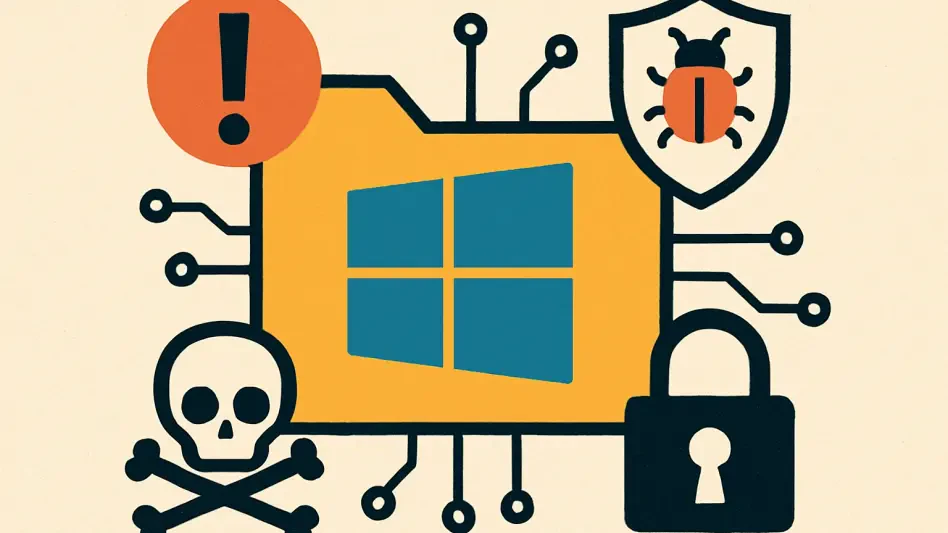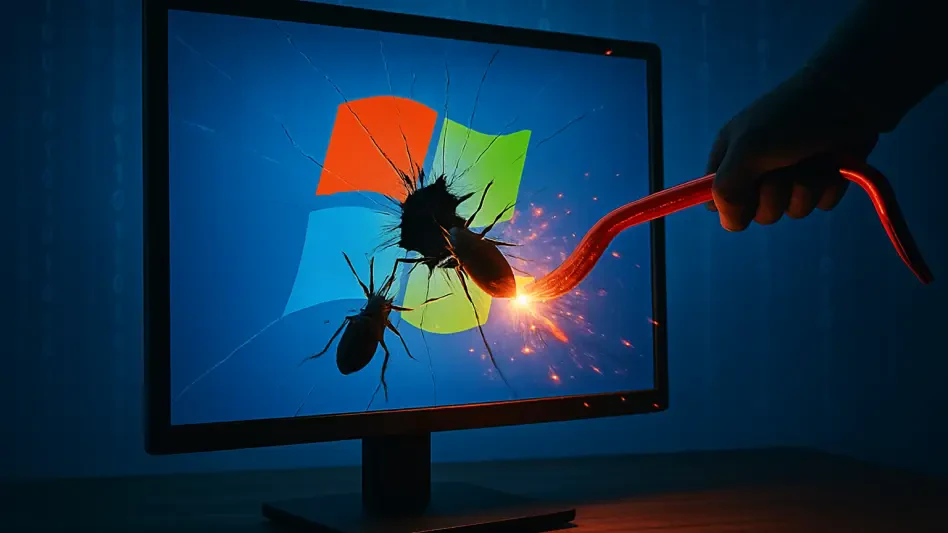In an era where cyber threats evolve at an alarming pace, the significance of timely software updates cannot be overstated, especially when it comes to Microsoft’s Patch Tuesday releases, which serve as a crucial defense mechanism. Each month, this scheduled rollout addresses a myriad of vulnerabilities across various systems, acting as a frontline defense for organizations worldwide. The latest update tackles an impressive 81 vulnerabilities, including two zero-day flaws that, while not yet exploited, have been publicly disclosed, posing a latent threat to critical infrastructure. These updates are not just routine maintenance; they are a vital shield against potential disruptions in environments where downtime can have catastrophic consequences, such as hospitals or transportation hubs. The urgency to patch systems promptly stems from the sophisticated nature of modern attacks, where even seemingly minor flaws can be chained together for devastating impact. As cybercriminals continuously probe for weaknesses, understanding the critical nature of these updates becomes paramount for maintaining security and operational stability.
Addressing Zero-Day Threats in Critical Systems
The spotlight of the recent Patch Tuesday falls on two zero-day vulnerabilities that underscore the pressing need for immediate action. The first, identified as CVE-2024-21907, impacts Newtonsoft.Json within SQL Server, potentially triggering a denial of service through mishandling of deeply nested JSON objects. Though its primary effect is service disruption rather than data theft, the implications are severe in high-stakes settings where uninterrupted operation is non-negotiable. Think of a hospital relying on real-time data for patient care or an airport managing flight schedules—any downtime could lead to chaos. Microsoft has prioritized this fix, recognizing that while the threat level may not be catastrophic in isolation, the context of its application elevates its importance. Organizations must weigh the risk of temporary disruption during patching against the far graver consequences of leaving systems exposed to such vulnerabilities.
Equally concerning is the second zero-day, CVE-2025-55234, a Windows SMB elevation of privilege flaw that can be exploited remotely through replay attacks. This vulnerability opens the door for attackers to gain higher access rights and execute malicious code, posing a significant risk to network security. Microsoft offers mitigation strategies like SMB Server Signing and Extended Protection for Authentication, but warns of potential compatibility issues with third-party systems. To assist, audit tools are provided to evaluate the impact of enabling these protections before full implementation. This approach highlights a delicate balance between bolstering security and maintaining operational continuity. For IT teams, the challenge lies in navigating these trade-offs while ensuring that critical systems remain safeguarded against attackers who could exploit such flaws to infiltrate deeper into networks.
Tackling High-Risk Elevation of Privilege and Remote Code Flaws
Beyond zero-days, the latest update addresses a substantial number of elevation of privilege (EoP) vulnerabilities, with 41 identified, alongside 22 remote code execution (RCE) flaws. Several EoP issues, including those affecting the Windows Kernel, TCP/IP Driver, and Hyper-V, are rated as “exploitation more likely” by Microsoft, signaling a heightened urgency for remediation. Although local privilege escalation flaws often carry lower severity scores, their danger lies in what follows initial access. Once attackers gain a foothold—through phishing, stolen credentials, or other RCE exploits—these vulnerabilities allow them to escalate permissions, disable security measures, and deploy malware. Such actions can facilitate lateral movement across networks, turning a minor breach into a full-scale compromise. Prioritizing these patches is essential to prevent attackers from exploiting these pathways to wreak havoc on enterprise systems.
Delving deeper into the update, only a small fraction of the addressed flaws are classified as critical, with two EoP and five RCE vulnerabilities earning this designation. However, the broader context reveals that even lower-rated issues can pose significant risks when combined in a chained attack scenario. Cybercriminals often leverage multiple vulnerabilities to maximize damage, making comprehensive patching a non-negotiable strategy. The challenge for organizations is not just applying updates but doing so in a way that minimizes disruption to existing configurations. Microsoft’s guidance emphasizes the importance of testing patches in controlled environments before widespread deployment. This cautious approach ensures that security enhancements do not inadvertently break critical applications, reflecting the complex interplay between safeguarding systems and maintaining seamless operations in today’s interconnected digital landscape.
Balancing Security with Operational Stability
The recurring theme of this Patch Tuesday is the ongoing tension between enhancing security and preserving operational stability. Enabling protective features to counter vulnerabilities often comes with the risk of disrupting existing setups, particularly when third-party integrations are involved. Microsoft acknowledges this dilemma by providing tools to assess compatibility impacts before full implementation of security measures. This proactive stance empowers organizations to make informed decisions, mitigating the risk of unintended downtime or functionality issues. For many, the decision to patch immediately must be weighed against potential interruptions, especially in industries where even brief outages can have far-reaching consequences. The key takeaway is that while updates are indispensable, their deployment requires strategic planning to align with organizational priorities and risk profiles.
Reflecting on the broader implications, the latest batch of updates tackled a wide array of threats, from zero-day vulnerabilities to high-likelihood exploitation risks affecting core components like SQL Server and Windows SMB. Microsoft’s response demonstrated a commitment to fortifying systems against evolving cyber dangers, even as it navigated the complexities of potential disruptions. Looking ahead, organizations were urged to adopt a proactive stance, leveraging provided tools to evaluate and implement patches with minimal impact. The focus shifted to strategic planning—testing updates in isolated environments and prioritizing critical systems to ensure robust defense without sacrificing functionality. As cyber threats continued to grow in sophistication, the importance of staying ahead through timely and thoughtful patching became a cornerstone of effective cybersecurity, guiding enterprises toward a more secure future.








